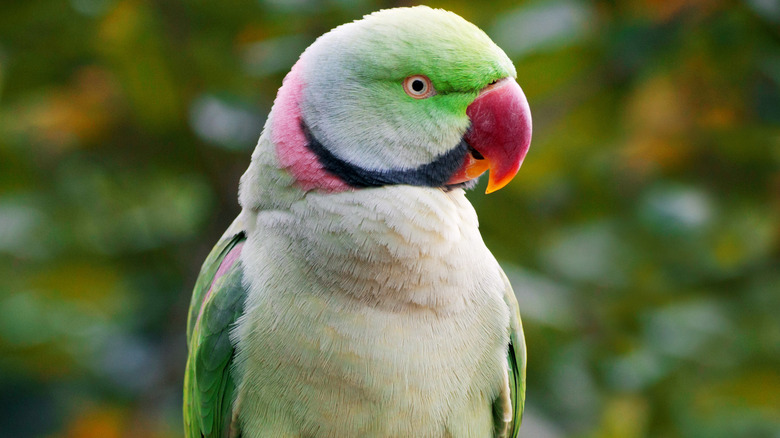Breeding Behavior Of The Indian Ringneck Parakeet
Indian ringneck parakeets, also known as rose-ringed parakeets, are striking, medium-sized parrots with large personalities. They're extremely active, social birds that are able to learn up to 200 words, making them very intelligent and stimulating pets for the energetic and dedicated bird owner. Because of these desirable qualities, Indian ringneck parakeets are fairly common, at least in the U.S., and you can adopt them from rescue organizations and breeders alike.
But what about breeding, you ask? Well, wild Indian ringneck parakeets tend to nest in holes that they find in trees and walls, with common roosting locations including grain silos. They most often breed in the winter, which is advantageous because there's not much competition for nesting locations during these colder months and the females can feed on the season's pea crop to reap plenty of nutrients while breeding, which helps them produce eggs. These bright birds usually only breed once a year, but they can breed twice depending on their location around the world.
Male and female parakeets are generally quite doting with each other while breeding, but in captivity, they don't have to remain by each other's side at all times and can enjoy some space. Ultimately, Indian ringneck parakeets are special animals for the right pet parent, but they require a lot of space and a lot of care so they can live their best life in captivity.
Male vs. female breeding behavior in Indian ringneck parakeets
When starting your breeding journey, you may be wondering how to tell if your Indian ringneck is male or female. Luckily, it's a simple matter of observation. The Indian ringneck parakeet is a dimorphic bird, meaning that the sex can be determined by observing your pet's colors and markings. These parakeets are known as bright-green birds, but they actually can be a variety of different colors, including yellow, blue, lutino, and even albino. No matter the dominant color of the bird, males generally have black markings on their face, three rings of color around their necks, and a red beak. Females are also brightly colored, but they don't have the vibrant facial markings and different-colored rings that male parakeets sport.
While males may attempt to breed at 2 years old, they're not generally fruitful until they reach 3 or 4 years old (and beyond). On the contrary, females may start laying eggs at the age of 2, and if she's paired with a male that doesn't know what to do, she may kill him. We told you these are feisty birds!
Obviously, females are the ones that lay eggs — usually around four to six in a nest — and only the females usually incubate the eggs (typical, right?). Once baby Indian ringneck parakeets are about 6 or 7 weeks old, they leave the nest, and in captivity, these fascinating birds can live for up to 34 years.
How to breed Indian ringneck parakeets in captivity
If you're a serious bird breeder, you need to know how to breed ringneck parrots or parakeets correctly. As you may be able to tell, they are particular birds that require certain specifications to ensure successful breeding, so learning how to build nesting boxes for your Indian ringneck parakeets is imperative. According to Rodney P. Silva in a 1997 issue of AFA [American Federation of Aviculture] Watchbird Magazine (PDF), one thing you can do if you're breeding these birds in captivity is put "juvenile birds where they can watch the older birds breed and court." After observing other birds mating, they're more inclined to breed correctly themselves.
Other important things to have in place for breeding success include large cages with enough space for the birds to fly, some solid walls so they can have privacy around their nest, and a healthy, balanced diet. Breeding birds is not something you do on a whim. It requires real investment, lots of space, and special habitats and equipment. Indian ringneck birds, in particular, are smart and spirited animals that aren't going to be the right choice for every pet owner but can be rewarding companions for those who are serious about birds.


